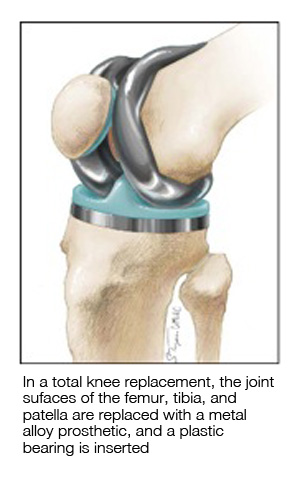What are the different types of knee surgery?
When you’re looking at different types of knee surgery, you want to understand the distinctions.
What is a “total knee” replacement?

Total knee replacement is a surgical procedure that removes all (hence, “total”) diseased joint surfaces in the knee, and replaces them with artificial surfaces. These artificial surfaces are metal alloys based on cobalt-chromium and titanium metals. Some total knee designs used overseas are made of ceramics; such designs are not used widely in the United States.
Actual movement of an artificial knee is between a very smooth, polished cobalt-chrome metal, contoured like your own knee, and a low-wear plastic bearing that sits inside a titanium tray designed to attach to bone. Ligaments inside the knee joint are removed, while ligaments supporting the knee on the outside are usually preserved.
A total knee replacement provides all new weight-bearing surfaces in the knee joint. It serves to decrease pain and increase motion in the joint since the synthetic metal and plastic surfaces do not have any nerves.
What is a “partial” knee replacement?
Total knee replacement involves all three compartments (or sub-joints) in human knee joints. Usually all three compartments are all worn out by arthritis, but in some knees, only one or two compartments may be arthritic. If so, the affected compartments can be replaced selectively, thereby preserving bone and minimizing surgery. Such knee replacements are called partial knee replacements.
Very few patients are proper candidates for partial replacements, despite the marketing claims of surgeons and manufacturers. If a partial replacement is done improperly, or in the wrong patient, premature repeat surgery is usually needed to put in a complete knee prosthesis, which likely should have been used in the first place.
Is recovery faster after a partial knee replacement?
Yes, in part, because all the knee ligaments (anterior cruciate ligament and posterior cruciate ligament) are preserved in all partial knee replacements. These ligaments are removed during a total knee replacement.
Newer knee implant systems now allow selective replacement of one or more arthritic compartments in the knee, thereby customizing the amount of surgery to each patient, and ensuring even faster recoveries. In these selective compartmental replacements, ligament preservation leads to earlier recovery, a more natural feeling joint after surgery, and less blood loss and surgical trauma.
Still, keep in mind that for most patients, a total knee replacement is usually the most durable and satisfactory option.
What is “minimally invasive” knee replacement?
The term “minimally invasive” is misleading, over-used, and abused. Many hospitals, companies, and doctors use the term simply as a means of attracting patients in today’s competitive health care environment. For many community surgeons, minimally invasive surgery means doing the same old operation through a shorter skin cut.
Minimally invasive or not, you should know that all surgery is inherently invasive. The response to surgery includes discomfort, altered emotions, nausea, altered appetite, constipation, and other unpredictable sensations. It takes time for the body, soul, and mind to heal.
Other conditions such as diabetes, heart disease, smoking, stress, obesity, and lack of family support can prolong recovery after any surgery.
How does your practice define “minimally invasive” surgery?
In our practice, minimally invasive knee surgery reflected a comprehensive treatment program involving the latest implants, better instrumentation, smaller incisions, improved anesthetic techniques, earlier rehabilitation, altered pain management techniques, enhanced patient communication, a team approach, surgical efficiency, and new surgical methods that reduce or eliminate trauma to muscles and tendons.
Our minimally invasive surgery program was a comprehensive and continually improving collaborative effort to bring together the latest technologies and techniques from the best surgeons and anesthesia doctors worldwide. It was based on the recognition that minimally invasive surgery can reduce, but cannot eliminate, the normal physiologic and psychological responses inherent to surgical trauma.